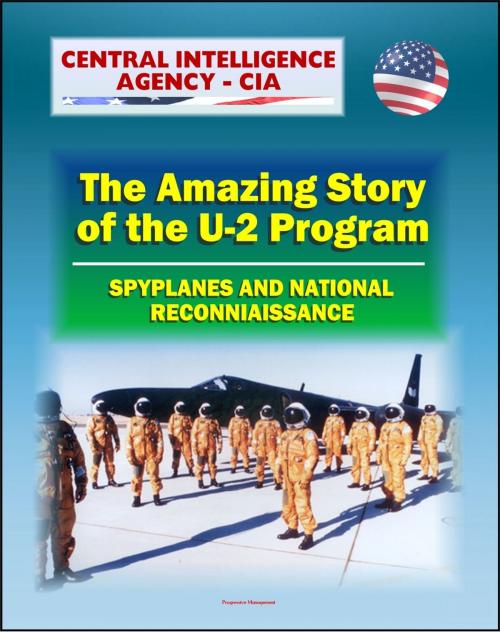Spyplanes and National Reconnaissance in the 20th Century: The Amazing Story of the U-2 Program, A-12 Oxcart, Francis Gary Powers Incident, Cuba Missile Crisis, Aquatone and Genetrix Projects
Nonfiction, Science & Nature, Technology, Military Science, History, Military| Author: | Progressive Management | ISBN: | 9781466161443 |
| Publisher: | Progressive Management | Publication: | November 8, 2011 |
| Imprint: | Smashwords Edition | Language: | English |
| Author: | Progressive Management |
| ISBN: | 9781466161443 |
| Publisher: | Progressive Management |
| Publication: | November 8, 2011 |
| Imprint: | Smashwords Edition |
| Language: | English |
This CIA History Staff Monograph offers a comprehensive and authoritative history of the CIA's manned overhead reconnaissance program, which from 1954 to 1974 developed and operated two extraordinary aircraft, the U-2 and the A-12 OXCART. It describes not only the program's technological and bureaucratic aspects, but also its political and international context. The manned reconnaissance program, along with other overhead systems that emerged from it, changed the CIA's work and structure in ways that were both revolutionary and permanent. The formation of the Directorate of Science and Technology in the 1960s, principally to develop and direct reconnaissance programs, is the most obvious legacy of the events recounted in this study.
Topics covered include: the U-2 and A-12 Oxcart program; manned overhead reconnaissance; Project Aquatone; the role of U-2 flights in UFO sightings and Operation Bluebook; pilots, pilot training, and suicide pills; Project Genetrix balloons; the Francis Gary Powers downing in May 1960; overflights of the Soviet Union; and more. Contents: Chapter 1, Searching for a System * Chapter 2, Developing the U-2 * Chapter 3, U-2 Operations in the Soviet Bloc and Middle East, 1956-1968 * Chapter 4, The Final Overflights of the Soviet Union, 1959-1960 * Chapter 5, U-2 Operations After May 1960.
The authors tell an engrossing story. The struggle between the CIA and the US Air Force lo control the U-2 and A-12 OXCART projects reveals how the manned reconnaissance program confronted problems that still beset successor programs today. The U-2 was an enormous technological success - its first flight over the USSR in July 1956 made it immediately the most important source of intelligence on the Soviet Union. Using it against the Soviet target it was designed for nevertheless produced a persistent tension between its program managers and the President. The program managers, eager for coverage, repeatedly urged the President to authorize frequent missions over the Soviet Union. President Eisenhower, from the outset doubtful of the prudence and propriety of invading Soviet airspace, only reluctantly allowed any overflights at all. After the Soviets shot down Francis Gary Powers' U-2 on 1 May 1960, President Eisenhower forbade any further U-2 flights over the USSR. Since the Agency must always assess a covert operation's potential payoff against the diplomatic or military cost if it fails, this account of the U-2's employment over the Soviet Union offers insights that go beyond overhead reconnaissance programs.
Indeed, this study should be useful for a variety of purposes. It is the only history of this program based upon both full access to CIA records and extensive classified interviews of its participants The authors have found records that were nearly irretrievably lost and have interviewed participants whose personal recollections gave information available nowhere else. Although the story of the manned reconnaissance program offers no tidy model for imitation, it does reveal how resourceful managers coped with unprecedented technological challenges and their implications for intelligence and national policy. For this reason, the program's history provides profitable reading for intelligence professionals and policymakers today.
This CIA History Staff Monograph offers a comprehensive and authoritative history of the CIA's manned overhead reconnaissance program, which from 1954 to 1974 developed and operated two extraordinary aircraft, the U-2 and the A-12 OXCART. It describes not only the program's technological and bureaucratic aspects, but also its political and international context. The manned reconnaissance program, along with other overhead systems that emerged from it, changed the CIA's work and structure in ways that were both revolutionary and permanent. The formation of the Directorate of Science and Technology in the 1960s, principally to develop and direct reconnaissance programs, is the most obvious legacy of the events recounted in this study.
Topics covered include: the U-2 and A-12 Oxcart program; manned overhead reconnaissance; Project Aquatone; the role of U-2 flights in UFO sightings and Operation Bluebook; pilots, pilot training, and suicide pills; Project Genetrix balloons; the Francis Gary Powers downing in May 1960; overflights of the Soviet Union; and more. Contents: Chapter 1, Searching for a System * Chapter 2, Developing the U-2 * Chapter 3, U-2 Operations in the Soviet Bloc and Middle East, 1956-1968 * Chapter 4, The Final Overflights of the Soviet Union, 1959-1960 * Chapter 5, U-2 Operations After May 1960.
The authors tell an engrossing story. The struggle between the CIA and the US Air Force lo control the U-2 and A-12 OXCART projects reveals how the manned reconnaissance program confronted problems that still beset successor programs today. The U-2 was an enormous technological success - its first flight over the USSR in July 1956 made it immediately the most important source of intelligence on the Soviet Union. Using it against the Soviet target it was designed for nevertheless produced a persistent tension between its program managers and the President. The program managers, eager for coverage, repeatedly urged the President to authorize frequent missions over the Soviet Union. President Eisenhower, from the outset doubtful of the prudence and propriety of invading Soviet airspace, only reluctantly allowed any overflights at all. After the Soviets shot down Francis Gary Powers' U-2 on 1 May 1960, President Eisenhower forbade any further U-2 flights over the USSR. Since the Agency must always assess a covert operation's potential payoff against the diplomatic or military cost if it fails, this account of the U-2's employment over the Soviet Union offers insights that go beyond overhead reconnaissance programs.
Indeed, this study should be useful for a variety of purposes. It is the only history of this program based upon both full access to CIA records and extensive classified interviews of its participants The authors have found records that were nearly irretrievably lost and have interviewed participants whose personal recollections gave information available nowhere else. Although the story of the manned reconnaissance program offers no tidy model for imitation, it does reveal how resourceful managers coped with unprecedented technological challenges and their implications for intelligence and national policy. For this reason, the program's history provides profitable reading for intelligence professionals and policymakers today.















